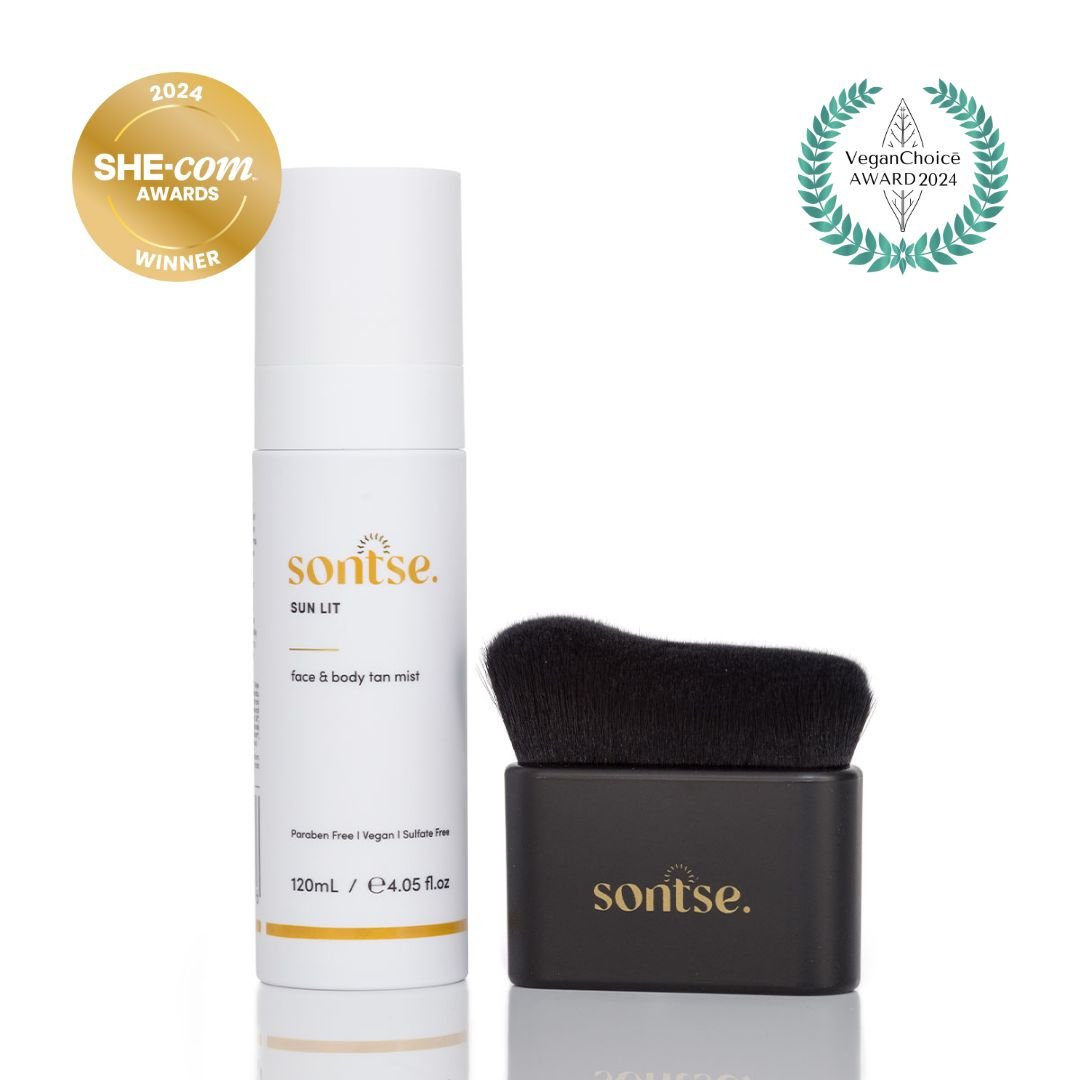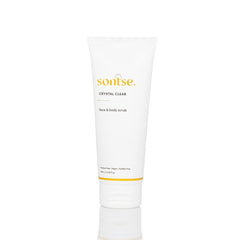In this Q&A style article below, we answer all your questions to bust the common myth that you can’t tan (or burn) with a fake tan on. By explaining how UV rays work versus how self-tanner works, we show you the importance of practicing sun safety with a fake tan. So can you tan with a fake tan on? The facts speak for themselves. The good news is: knowledge is power. So sit back, relax, and know that you’re connected with a sunless tanning brand that goes above and beyond to empower you with the sun safety wisdom you need to make more mindful, educated decisions that truly love on your skin.
Can you tan with a fake tan on?
We say this with a lot of caution. The answer is yes when it comes to ‘Can you tan with self tanner on?’ or even ‘Can you tan over fake tan?’
But these definitely shouldn’t be the goal. We know there’s a common misconception out there that you can just use your self-tanner to get an instant glow in the interim while you wait for a UV sun tan to set in.
If you have naively been a victim of this mindset, please read this article carefully. You could be doing your skin more harm than good and, honestly, prematurely aging or risking the chance of developing skin cancer or melanoma.
Let us explain. In an American study by Dodds, MD et al. (2018) it outlines how sunless tanning, if not followed through with sun-safe exposure, can be just as harmful.
“Sunless tanning is a safe alternative to achieve tanned skin that might help reduce skin cancer incidence by deterring risky behaviors. However, limited data exist on the characteristics and associated skin cancer risk behaviors of sunless tanners in the United States.”
Furthermore, the article references a prior study by Sahn. M.D et al. (2012) that found,
“Sunless tanners are more likely to use sunscreen but otherwise have poor sun-protective behaviors.”
Although these studies were conducted in America, our heart is to inform a world-wide audience, starting with our own nation, that sunless tanning must go hand-in-hand with practicing safe sun exposure outdoors. Simply adding a fake tan to poor sun safety habits is not enough friends!
Can you tan over fake tan? Aka can you tan with self tanner on?
To answer the question ‘Can you get a natural tan with fake tan on?’, it’s helpful to understand how self-tanner works compared to UV rays.
So here’s the lowdown: the tan you can achieve with a sunless tanner is a heck of a lot safer than a regular UV-created tan.
According to an article by the Skin Cancer Foundation,
‘The active ingredient in most sunless tanners is the coloring agent DHA (dihydroxyacetone), which combines with amino acids in the skin. The resulting reaction causes browning, but unlike the reaction caused by UV rays, it involves only the outermost, dead cell layer of the skin.’ (Venosa & Kleiman, 2019).
When it comes to UV radiation on the otherhand, Hyde (2022) explains that there are two types of UV radiation that affect your skin: UVA and UVB.
“UVA radiation is what makes people tan. UVA rays penetrate to the lower layers of the epidermis, where they trigger cells called melanocytes (pronounced: mel-AN-oh-sites) to produce melanin. Melanin is the brown pigment that causes tanning.”
Now although this may seem alluring, to go after, Hyde (2022) further warns,
“UVA rays may make you tan, but they can also cause serious damage. That's because UVA rays penetrate deeper into the skin than UVB rays. UVA rays can go all the way through the skin's protective epidermis to the dermis, where blood vessels and nerves are found.
“Because of this, UVA rays may damage a person's immune system, making it harder to fight off diseases and leading to illnesses like melanoma, the most serious type of skin cancer. Melanoma can kill. If it's not found and treated, it can quickly spread from the skin to the body's other organs.” (Hyde, 2022)
With this is in mind, it’s important to realise that just because you’ve put a topical sunless tanner on your skin, it won’t affect UVA from penetrating into the deeper layers of your skin which can be potentially fatal in the long run.
Does fake tan have any SPF?
It’s important to note that most quality self tanners that give off a beautiful, full-coverage, flawless glow are not able to combine a high SPF sunscreen in the formulation. Remember there is a lot that goes into keeping the formulation clean, non-toxic and effective for a beautiful colour application.
Nonetheless, should there be a sunless tanner out there with claims of SPF in their formula, be extra curious to understand the quality of the SPF and whether this compromises the overall look of the tan.
Do I need to wear sunscreen when I have fake tan on? Can you tan over self tanner?
Now that we’ve pushed to the curb the questions, of ‘Can you tan over self tanner?’ And ‘Does fake tan have any SPF?’ We’re pretty sure you can probably guess the answer, when it comes to whether you need to wear sunscreen when you have a fake tan on.
But, just incase it’s not super clear… the answer is YES! Please, always apply sunscreen as the last step in your self-tanning routine before stepping outside.
Want an expert opinion? According to an article by the Skin Cancer Foundation,
“Sunscreen and protective clothing should always be used in conjunction with sunless tanners,” she says. “They don’t provide adequate protection from UV rays.
“A proper sun protection regimen — whether you’re rocking your natural skin tone or a self-tanner—includes seeking shade, daily application of a broad-spectrum sunscreen with an SPF of 15 or higher and covering up with clothing, including a broad-brimmed hat and UV-blocking sunglasses. If you’re going to be out for an extended period in the sun, use an SPF 30 or higher, broad-spectrum, water-resistant sunscreen.” (Venosa & Kleiman, 2019)
This really does highlight the importance of sun safety with a fake tan.
Will applying SPF fade my fake tan?
Although we can’t speak for other brands, the good news is our Sontse sunless tanner is compatible with most SPF formulations… meaning it’s actually designed to have SPF applied after you have rinsed off the tan, without it fading your fake tan.
A few things to remember here… don’t combine the fake tan with SPF in the development process. You first need to apply our fake tan without combining any other products. Allow the product to fully develop and then rinse it off for the development process to complete. At this point it is safe to add moisturiser and SPF sunscreen.
If you need some suggestions on some of our favourite sunscreens to use with our self-tanner… here are our top three:
- BEAUTI-FLTR Feather Light SPF 50+
- Alpha-H Daily Essential Moisturiser SPF 50+
- Ultra Violette Fave Fluid SPF 50+ Ultralight Fragrance Free Skinscreen™
So there you have it. A complete Q&A debunking the doubts on the question ‘Can you tan over self tanner?’ What do you think? Want to know more? Here’s 6 essential tips on how to be sun safe.
References
Dodds, M/D, M., Arron, MD, PhD,, S. T., Linos, MD, MPH, DrPH,, E., Polcari, MD, I., & Mansh, MD, M. D. (2018, Jul 25). JAMA Dermatol. Characteristics and Skin Cancer Risk Behaviors of Adult Sunless Tanners in the United States, 154(9), 1066–1071. 10.1001/jamadermatol.2018.2054
Hyde, P. (2022, August). Tanning (for Teens) | Nemours KidsHealth. Kids Health. Retrieved April 23, 2024, from https://kidshealth.org/en/teens/tanning.html
Sahn. M.D, R. E., McIlwain, M.D, M. J., & Magee, M.D, K. H. (2011). Arch Dermatol. A Cross-sectional Study Examining the Correlation Between Sunless Tanning Product Use and Tanning Beliefs and Behaviors, 148(4), 448-454. doi:10.1001/archdermatol.2011.2072
Venosa, A., & Kleiman, J. (2019, August 11). Fake it to Make it: Sunless Tanning Explained. The Skin Cancer Foundation. Retrieved April 23, 2024, from https://www.skincancer.org/blog/sunless-tanning-explained/





















